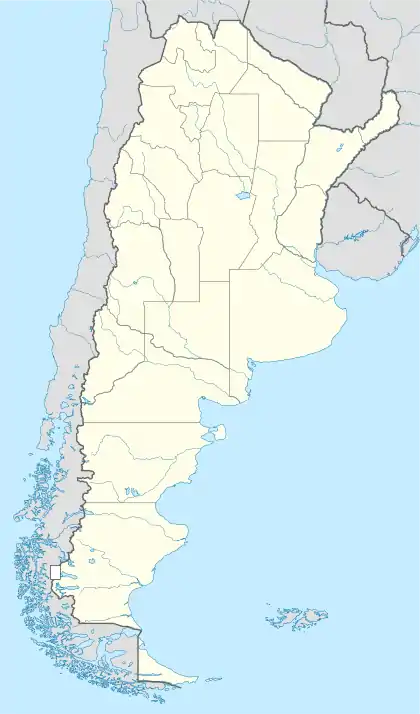Rosario – Islas Malvinas International Airport
Rosario – Islas Malvinas International Airport (Spanish: Aeropuerto Internacional de Rosario – Islas Malvinas) (IATA: ROS, ICAO: SAAR), formerly known as Fisherton International Airport, is located 13 km (8.1 mi) west-northwest[2] from the center of Rosario, a city in the Santa Fe Province of Argentina. The airport covers an area of 550 ha (1,400 acres) and is operated by the Province of Santa Fe.[2][3]
Rosario – Islas Malvinas International Airport Aeropuerto Internacional de Rosario – Islas Malvinas | |||||||||||
|---|---|---|---|---|---|---|---|---|---|---|---|
 | |||||||||||
| Summary | |||||||||||
| Airport type | Public | ||||||||||
| Operator | Province of Santa Fe | ||||||||||
| Serves | Rosario, Argentina | ||||||||||
| Elevation AMSL | 85 ft / 26 m | ||||||||||
| Coordinates | 32°54′13″S 60°47′04″W | ||||||||||
| Map | |||||||||||
 ROS Location of airport in Argentina | |||||||||||
| Runways | |||||||||||
| |||||||||||
| Statistics (2016) | |||||||||||
| |||||||||||
The airport serves the Greater Rosario area and is served by Aerolíneas Argentinas, Gol Transportes Aéreos, Azul Linhas Aereas, Flybondi, COPA and LATAM Airlines. There are domestic flights within Argentina from Rosario to Buenos Aires, Córdoba, Salta, Puerto Iguazú, San Carlos de Bariloche, El Calafate, Mar del Plata (via Buenos Aires), Mendoza (vía Córdoba), Santa Fe (via Buenos Aires) and Villa Gesell (only in summer, via Buenos Aires) cities as well as international services to São Paulo, Santiago de Chile, Lima, Panama, Florianópolis, Rio de Janeiro, Brazil, and Punta del Este, Uruguay (direct flight in summer and via Buenos Aires in fall, winter and spring).
The airport is at an elevation of 26 m (85 ft) and the runway is 3,000 m × 60 m (9,843 ft × 197 ft). The Rosario VOR-DME (Ident: ROS) is located on the field.[4]
A new terminal was constructed between 2003 and 2004, effectively making Rosario an international airport.
During the first years of the 21st century the Rosario Airport lost a considerable volume of air traffic, even after being updated and expanded in 2003–2004. In 2005 there were only 1,807 flights, about 75% less than in 2000. Since 2013, however, it has been steadily growing in both traffic and connectivity.[5]
The airport's name reflects Argentina's claims of sovereignty over the Falkland Islands (Islas Malvinas in Spanish), and could be translated as "Rosario – Falkland Islands International Airport".
Airlines and destinations

See also
 Argentina portal
Argentina portal Aviation portal
Aviation portal- Transport in Argentina
- List of airports in Argentina
References
- Airport traffic
- "SAAR ROSARIO / ISLAS MALVINAS" (PDF) (in Spanish). Archived from the original (PDF) on 19 April 2009. (126 KB) at AIP Argentina
- (in Spanish) Aeropuerto Internacional Rosario "Islas Malvinas" Archived 7 February 2012 at the Wayback Machine at Organismo Regulador del Sistema Nacional de Aeropuertos (ORSNA)
- "Rosario VOR". Our Airports. Retrieved 25 April 2019.
- https://www.rosario3.com/noticias/Mas-de-740-mil-pasajeros-pasaron-en-2017-por-el-aeropuerto-de-Rosario-20171230-0002.html
- "Aerolíneas Argentinas inauguró la nueva ruta que une Rosario con Ezeiza" [Aerolíneas Argentinas inaugurated a new route linking Rosario with Ezeiza] (Press release) (in Spanish). Aerolíneas Argentinas. 3 January 2012. Retrieved 4 January 2012.
- http://www.impulsonegocios.com/contenidos/2014/06/10/Editorial_31103.php
- AR, increases flight to Salta
- Sica, Norberto (3 March 2016). "Copa Airlines arranca en julio a volar la ruta Rosario - Panamá". Impulso. Retrieved 3 March 2016.
- Liu, Jim. "JetSMART Argentina adds new routes from Nov 2019". Routesonline. Retrieved 7 August 2019.
- http://gestion.pe/empresas/lan-peru-anuncia-dos-nuevas-rutas-aumentar-conectividad-aerea-entre-peru-y-argentina-2154320
External links
- OpenStreetMap - Rosario Airport
- El Aeropuerto Internacional de Rosario(in Spanish) at City of Rosario website
- Aeropuerto Internacional Rosario "Islas Malvinas"(in Spanish) at Organismo Regulador del Sistema Nacional de Aeropuertos
- Current weather for SAAR at NOAA/NWS
- Accident history for ROS at Aviation Safety Network